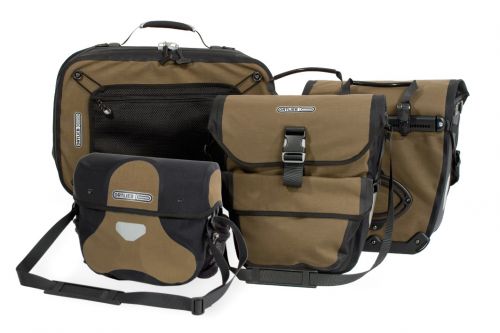By Chris Lesser
It was after completing a 2,300-mile bicycle tour from Oregon to Texas in 1980 that Wayne Borroughs began dreaming of opening up a bike shop to help perpetuate his love of bicycle travel. Borroughs worked at a shop in Fort Collins, Colorado, for seven years before opening up his own store, which he ran for another seven. But neither experience truly scratched his itch for touring bikes.
“If I brought in just a dozen pairs of panniers and some good racks, and sold through them all by the end of the year, then I was doing well,” recalled Borroughs. “Before the Internet it was very difficult to focus on touring in a local market.”
Of course, then the Internet came, and as it did Borroughs closed his bike shop in order to focus on a touring-specific online store. First he concentrated on eBay sales, but by the early 2000s he began shifting his focus to his consumer-direct website, TheTouringStore.com. Today Burroughs is one of three full-time employees, and with the exception of one flat year when the stock market tanked, growth has been steady year after year even as the online competition has heated up, and as bike shops nationwide have picked up their collective game in catering to a rising number of urban and utility cyclists—and by proxy, to true bicycle tourists.
While it’s hard to parse touring bike and accessory sales from available numbers, let alone separate commuters from actual bicycle tourists, anecdotal evidence and reports from manufacturers all suggest a definite swell in the touring market over the past several seasons.
“Bike touring used to be a niche activity, but now it’s branched into several areas,” said Michael Deme, publications director for the Adventure Cycling Association in Missoula, Montana.
“Six or seven years ago the chances of going into any bike shop in America and finding a set of panniers that were good enough for a two-week trip were not good. Now we see that changing. We’re seeing the standard road touring crew riding loaded-up bicycles extremely long distances, but then there’s the bikepacking crew doing the Great Divide, and there are also many bike companies are also doing bike tours.”
The ACA has experienced back-to-back banner years, noted Deme. “We’ve gone from being $30,000 in the red five years ago to netting positive numbers that keep going up,” he said.
In the past decade ACA membership has gone up 19 percent, its map sales are up 48 percent, and donations have tripled. The nonprofit now operates with a $4.1 million budget, and its network of mapped bike routes has grown to 42,000. Three of those routes go through Missoula, and more than 1,000 bike tourists stop into ACA headquarters every year.
EXTENDING THE SALE
Aside from ACA’s success, the most telling barometer of the health of bicycle touring is actual bike and accessory sales.
“I can’t help but think it is growing,” said Salsa brand manager Jason Boucher, who is quick to add that although Salsa’s sales in the category are strong, the brand has only been at it since 2009, when it introduced its Vaya touring bike. Since then the Vaya has grown from one to three models, and for 2013 the top-level titanium model is being replaced by a stainless steel version with S&S couplers called the Vaya Travel.
While Salsa may still be a relative newcomer, its sibling brand Surly is a veteran with its Long Haul Trucker. Though unit sales were not made available, nearly every shop contacted for this story reported strong sales of the $1,275 touring bike.
Five years ago the Bike Biz in Sacramento was raking in fixie sales, but as that category has died down the shop has taken to stocking a full size run of Long Haul Truckers to take up the slack. Manager Zach Waddle said he moves a couple a week, with solid accessory sales to boot.
“It’s not just putting on a rack and panniers and calling it good,” said Waddle. “We pretty much sell one or two racks instantly, plus a Brooks saddle, maybe a Pleschler double kickstand, and either Velo Orange or Honjo fenders. On average it’s probably $400 to $600 in accessories with every bike.”
VARIETY OF TOURERS
So who’s buying all this stuff?
Although the ACA’s median age (out of 45,000 members) is 57, the younger crowd is less likely to pay a $40 fee to sign up, and reports across the board indicate shifting demographics.
“We’ve always seen the traditional 50-plus crowd, but we’ve seen two other demographics emerging in recent years,” said Jeff Scully, president of Ortlieb USA, which has seen double-digit growth year after year.
“One is families doing shorter overnight trips, camping and/or picnicking along the way. That’s definitely a trend. The other is 20- and 30-somethings—we’re seeing more and more loading up a bike and going adventure touring, or adventure backcountry touring.”
So-called credit-card touring—packing light and using lodging and restaurants instead of camping and cooking—also appears to be on the rise, and touring companies like Arkel are fielding new products to meet the demand.
Arkel’s offerings include the $100 Randonneur rack, which fits even lightweight road bikes by attaching to the seat rails and seatpost, and the sleek $110 TailRider trunk bag. Together with a handlebar bag these products can quickly mount to any non-dedicated touring bikes and hold enough for a weeklong credit-card tour.
Joe Kurmaskie, an expedition bicycle tourist and author who now works for Arkel, says business is up more than 200 percent in the past three years.
“Bicycle manufacturers have begun approaching us about selling our bags with their bikes,” he says. “That tells us the market for touring has just blown up.”


